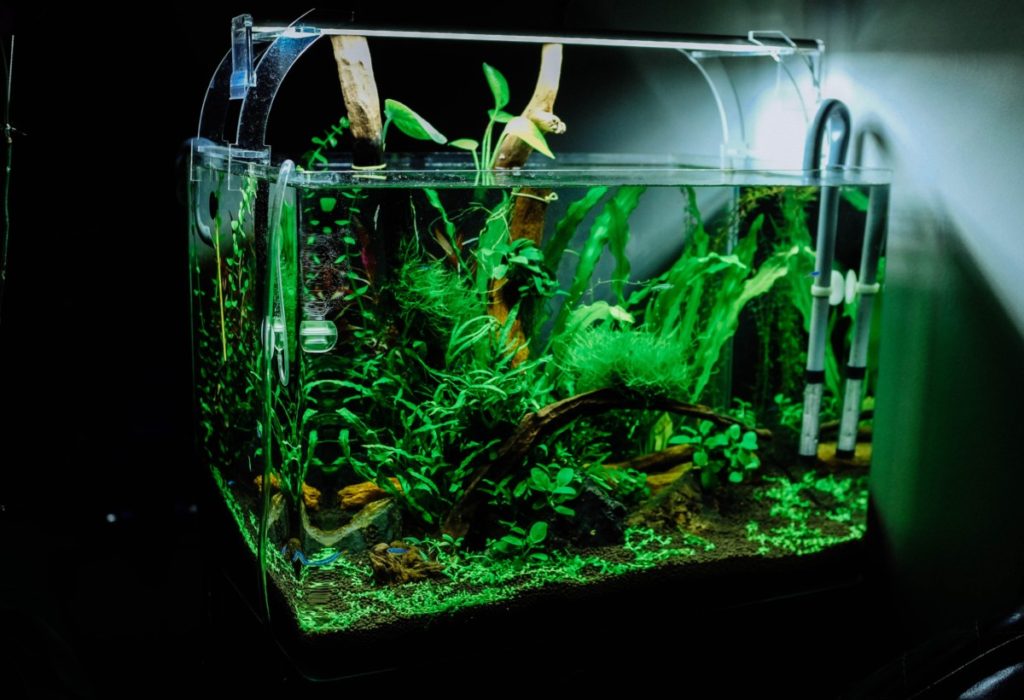Setting up a nano tank for the first time can be a difficult task for small aquarium enthusiasts. One of the first steps is to decide whether to install a nano tank filter.
Given the relatively small size, nano tanks can experience rapid changes in water quality where physical and chemical pollutants can build up quicker than a regular tank. Using a filter in a small aquarium can provide several benefits that we will discuss in this article.
What Is A Nano Fish Tank Filter?
All fish tanks will produce physical and chemical wastes that need to be reduced. A nano fish tank filter is a pump is designed to regulate water quality and remove toxic chemicals to improve the health of your plants and fish.
The most common sources of waste in a fish tank come from excess fish food, excretion of fish waste, and decaying plant matter which generate unwanted chemicals in the water.
Benefits of Installing a Filter
There are several benefits and reasons to use a filter within a nano tank which include:
- Provide mechanical and biological filtration to improve water quality.
- Help to oxygenate the water by agitating the surface.
- Reduce the amount and frequency of maintenance you need to do.

1. Improve Water Quality
Using a filter within a nano tank will reduce toxic waste and maintain a healthy water quality level. The two primary means of filtration are mechanical and biological.
Mechanical filtration
Mechanical filtration works by pumping water through the media (e.g. sponges, filter wool or floss, or pads) contained within the nano filter to collect debris. The filter will remove suspended particles from the water column and assist the clarity of the water.
Water pumped into your filter should first pass through a coarse filter pad. This will remove any larger pieces of debris and floating matter such as leaves and excess food. Following this, you should have some fine filter mesh to catch any smaller particles that were not caught by the coarse mesh.
Biological filtration
Biological filtration is essential for all aquariums even if you decide to try a filter-less setup. Organic matter will accumulate in all aquariums and produce ammonia which is toxic to fish at high levels. Biological filtration involves the use of beneficial bacteria to convert harmful chemicals into less harmful products. Whilst beneficial bacteria will live in your soil substrate (if you have them) and on the surface of plants, wood, and rocks, a filter simply provides another space for beneficial bacteria to live in.
Beneficial bacteria are microorganisms that convert toxic ammonia into nitrite. Nitrite is then converted into nitrate which is relatively harmless. In the natural world, the conversion of ammonia to nitrate is called the nitrification process. However, when it comes to fish tanks, the process is referred to as ‘cycling’.
This natural process doesn’t mean that water changes are not needed. You should still perform regular water changes to remove excess nutrients (and any other water quality issues).
Plants will also consume nitrogen and help to breakdown harmful ammonia however this will only occur in the daytime when plants can photosynthesize. This is an incentive to keep plants (which also look great!) but only a heavily planted nano tank will provide this benefit and does not replace a filter.
2. Helping Your Fish Breathe
Water exiting a filter via its outflow will provide some water movement and circulation within your nano tank. If you have the outflow near the surface then it will create more surface area for oxygen to diffuse in the water and giving your fish more ‘air’ to breathe. But note, this is only a minor aspect.
Some fish also like different amounts of water flow. Fish like bettas prefer water movement to be slow, compared to tetras which prefer a bit more current. This is another benefit of having a filter.
3. Reduce Cleaning & Maintenance
A filter will reduce the amount of cleaning by improving and regulating the water quality. However, this does not mean you can abandon maintaining the fish tank. For nano tanks with a soil or gravel substrate, it is worthwhile to vacuum the base during water changes to remove any excess debris that has built up. The filter intake is unlikely to remove these. Keeping the glass clean is also just as important, not to mention to keep your aquarium visually pleasing.
Widely regarded as the most important maintenance task, doing regular water changes (e.g. removing 20% – 30% and replacing it with fresh water on a weekly basis) will help to remove excess nutrients and other toxins you may have. Not performing water changes means that an additional burden will be placed on your filter.
Frequently Asked Questions
Can Fish Survive Without A Nano Filter?
There are several different types of fish that can be kept in a nano tank, small bowl, or vase without a filter. The most common fish species that can be kept in a small aquarium without filtration include:
- Goldfish
- Bettas (otherwise known as Siamese Fighting Fish)
- Guppies
- White Cloud Minnows
- Blind Cave Tetras.
- Salt and Pepper Corydoras
- Zebra Danios
- Ember Tetra
- Pea Pufferfish
The types and number of fish you could keep without a filter would also be very limited.
How Often Should I Change The Water In A Nano Tank Without A Filter?
The primary purpose of having a filter installed in your nano tank is filtration. Specifically, to remove the build-up of ammonia. If you don’t have a filter installed, then you need to perform water changes on a more frequent basis which means more maintenance.
As a general rule of thumb, a minimum would be twice a week to remove ammonia and other toxins from the water. Each water change should replace approximately 40% – 50% with fresh water. However, if you have several fish then it means your tank is likely to have a higher bioload. This means that more waste is being produced which leads to more ammonia. If this is the case, then you should be doing water changes three or more times a week.
Conclusion
Whilst having a filter in your nano aquarium is not essential, the benefits it brings are often too great to ignore. The health of your fish and plants is directly related to the quality of your water. A filter will be running all the time to ensure you have the best possible water quality.
Related articles:

